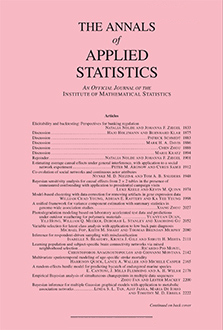Abstract
The modeling of spatiotemporal trends in temperature extremes can help better understand the structure and frequency of heatwaves in a changing climate and assess the environmental, societal, economic and health-related risks they entail. Here, we study annual temperature maxima over Southern Europe using a century-spanning dataset observed at 44 monitoring stations. Extending the spectral representation of max-stable processes, our modeling framework relies on a novel construction of max-infinitely divisible processes which include covariates to capture spatiotemporal nonstationarities. Our new model keeps a popular max-stable process on the boundary of the parameter space, while flexibly capturing weakening extremal dependence at increasing quantile levels and asymptotic independence. This is achieved by linking the overall magnitude of a spatial event to its spatial correlation range in such a way that more extreme events become less spatially dependent, thus more localized. Our model reveals salient features of the spatiotemporal variability of European temperature extremes, and it clearly outperforms natural alternative models. Results show that the spatial extent of heatwaves is smaller for more severe events at higher elevations and that recent heatwaves are moderately wider. Our probabilistic assessment of the 2019 annual maxima confirms the severity of the 2019 heatwaves both spatially and at individual sites, especially when compared to climatic conditions prevailing in 1950–1975. Our results could be exploited in practice to understand the spatiotemporal dynamics, severity and frequency of extreme heatwaves and to design suitable region-specific mitigation measures.
Funding Statement
This publication is based upon work supported by the King Abdullah University of Science and Technology (KAUST) Office of Sponsored Research (OSR) under Award No. OSR-CRG2017-3434.
Acknowledgments
The authors would like to thank the Editor, Associate Editor and two referees for valuable suggestions that have improved the manuscript.
Citation
Peng Zhong. Raphaël Huser. Thomas Opitz. "Modeling nonstationary temperature maxima based on extremal dependence changing with event magnitude." Ann. Appl. Stat. 16 (1) 272 - 299, March 2022. https://doi.org/10.1214/21-AOAS1504
Information






